The Influence of R&D in Mining on Sustainable Development in China
Abstract
1. Introduction
2. Theoretical Review
2.1. Sustainable Development in Mining (Coal) Sector
2.2. Coal Mining Sector Challenges and Innovation in R&D
3. Methodology and Data
3.1. The DEA-Based Malmquist Productivity Index
3.2. Sample Parameters
3.3. Indicator Selection
4. Results and Discussion
4.1. Inclination of R&D and Capabilities of Sustainable Development of Coal Mining Cities
4.2. Conversional Decomposition of Sustainable Development Capabilities of Coal Mining Cities
4.3. Comparative Analysis of R&D Influence and Effectiveness Appraisal
5. Conclusions and Direction for Future Study
5.1. Conclusion Remarks
- (1)
- The R&D inclination for all the coal mining cities was stable but low at 0.3406 average level and needs improvement even though the trends of other single years and groups were more significant. Stability in both optimal and actual values influenced sustainable development capabilities of all the coal mining cities in 2013. R&D as an input resources influence has not reached the production frontier despite being significant in some specific periods; it needs an upward review to be more effective.
- (2)
- A combined average of sustainable development capability as low as 0.6918 was achieved for all four groups of coal mining cities from 2008 to 2017, with a gap of 0.0971 in sustainable development capabilities existing between the highest performing and the lowest performing cities. This creates the need for steady efforts to be made towards ensuring the enhancement and stability of sustainable development capabilities in coal mining cities. From the trend analysis, the main obstacle that significantly hindered the sustainable development of most mining cities was insufficient desired inputs indicators, especially from inefficiencies of decisional capacity, recovery, and effectiveness. Generally, the best performing category in sustainable development capabilities was the growing cities, followed by regeneration cities, then declining and maturity. Despite this performance, there is no benchmark city for other coal cities to learn from in these four types of coal cities.
- (3)
- The total factor efficiency of the various coal mining cities from 2008 to 2017 was 1.044, which signifies a marginal change in the overall efficiency and resource management and utilization of the coal mining cities of China over the study period. Technical changes, which were the most influencing factor on sustainable development capabilities, recorded a significant average of 1.122. This implies that the influencing force of technological changes needed to promote sustainable development capabilities of coal mining cities grew by 12.2%, which is moderately significant but still needs improvement.
5.2. Policy Inferences
5.3. Direction for Future Study
Author Contributions
Funding
Institutional Review Board Statement
Informed Consent Statement
Conflicts of Interest
References
- Sahoo, A.K.; Sahoo, D.; Sahu, N.C. Mining export, industrial production and economic growth: A cointegration and causality analysis for India. Resour. Policy 2014, 42, 27–34. [Google Scholar] [CrossRef]
- Belke, A.; Dobnik, F.; Dreger, C. Energy consumption and economic growth: New insights into the cointegration relationship. Energy Econ. 2011, 33, 782–789. [Google Scholar] [CrossRef]
- Bento, J.P.C.; Moutinho, V. CO2 emissions, non-renewable and renewable electricity production, economic growth, and international trade in Italy. Renew. Sustain. Energy Rev. 2016, 55, 142–155. [Google Scholar] [CrossRef]
- Boamah, K.B.; Du, J.; Bediako, I.A.; Boamah, A.J.; Abdul-Rasheed, A.A.; Owusu, S.M. Carbon dioxide emission and economic growth of China—the role of international trade. Environ. Sci. Pollut. Res. 2017, 24, 13049–13067. [Google Scholar] [CrossRef] [PubMed]
- Vance, L.; Eason, T.; Cabezas, H. Energy sustainability: Consumption, efficiency, and environmental impact. Clean Technol. Environ. Policy 2015, 17, 1781–1792. [Google Scholar] [CrossRef]
- Dubiński, J. Sustainable development of mining mineral resources. J. Sustain. Min. 2013, 12, 1–6. [Google Scholar] [CrossRef]
- Endl, A.; Tost, M.; Hitch, M.; Moser, P.; Feiel, S. Europe’s mining innovation trends and their contribution to the sustainable development goals: Blind spots and strong points. Resour. Policy 2019, 101440. [Google Scholar] [CrossRef]
- Hou, Y.; Long, R.; Chen, H.; Zhang, L. Research on the sustainable development of China’s coal cities based on lock-in effec.t. Resour. Policy 2018, 59, 479–486. [Google Scholar] [CrossRef]
- Hou, Y.; Long, R.; Zhang, L.; Wu, M. Dynamic analysis of the sustainable development capability of coal cities. Resour. Policy 2020, 66, 101607. [Google Scholar] [CrossRef]
- Tang, D.F.; Jianguo, D.; Caesar, A.E.; Osei, A.A. Impact of Not in My Back Yard Conflict Management on Stakeholders: A Case of Bui Dam Project in Ghana. Arch. Bus. Res 2018, 6, 315–332. [Google Scholar]
- State Council. National Sustain. Development Plan for Resource-Based Cities [EB/OL]. (2013-12-03); General Office of the State Council: Beijing, China, 2013.
- Yu, J.; Li, J.; Zhang, W. Identification and classification of resource-based cities in China. J. Geogr. Sci. 2019, 29, 1300–1314. [Google Scholar] [CrossRef]
- Fernández, Y.F.; López, M.F.; Blanco, B.O. Innovation for sustainability: The impact of R&D spending on CO2 emissions. J. Clean. Prod. 2018, 172, 3459–3467. [Google Scholar]
- Romer, P.M. Increasing returns and long-run growth. J. Political Econ. 1986, 94, 1002–1037. [Google Scholar] [CrossRef]
- Li, L.; Lei, Y.; Pan, D.; Si, C. Research on sustainable development of resource-based cities based on the DEA approach: A case study of Jiaozuo, China. Math. Probl. Eng. 2016, 2016. [Google Scholar] [CrossRef]
- Wan, L.; Ye, X.; Lee, J.; Lu, X.; Zheng, L.; Wu, K. Effects of urbanization on ecosystem service values in a mineral resource-based city. Habitat Int. 2015, 46, 54–63. [Google Scholar] [CrossRef]
- Hopwood, B.; Mellor, M.; O’Brien, G. Sustainable development: Mapping different approaches. Sustain. Dev. 2005, 13, 38–52. [Google Scholar] [CrossRef]
- Waas, T.; Hugé, J.; Verbruggen, A.; Wright, T. Sustainable development: A bird’s eye view. Sustainability 2011, 3, 1637–1661. [Google Scholar] [CrossRef]
- Ali, S.H.; Giurco, D.; Arndt, N.; Nickless, E.; Brown, G.; Demetriades, A.; Durrheim, R.; Enriquez, M.A.; Kinnaird, J.; Littleboy, A. Mineral supply for sustainable development requires resource governance. Nature 2017, 543, 367. [Google Scholar] [CrossRef]
- Calas, G. Mineral resources and sustainable development. Elem.: Int. Mag. Mineral. Geochem. Petrol. 2017, 13, 301–306. [Google Scholar] [CrossRef]
- Cao, Y.; Bai, Z.; Zhou, W.; Zhang, X. Analyses of traits and driving forces on urban land expansion in a typical coal-resource-based city in a loess area. Environ. Earth Sci. 2016, 75, 1191. [Google Scholar] [CrossRef]
- Tilton, J.E. Exhaustible resources and sustainable development: Two different paradigms. Resour. Policy 1996, 22, 91–97. [Google Scholar] [CrossRef]
- Uhlenbruck, K.; Meyer, K.E.; Hitt, M.A. Organizational transformation in transition economies: Resource-based and organizational learning perspectives. J. Manag. Stud. 2003, 40, 257–282. [Google Scholar] [CrossRef]
- Chen, Y.-S.; Hsu, C.-J.; Hsiau, S.-S.; Ma, S.-M. Clean coal technology for removal dust using moving granular bed filter. Energy 2017, 120, 441–449. [Google Scholar] [CrossRef]
- Zhang, Y.; Sun, Y.; Qin, J. Sustainable development of coal cities in Heilongjiang province based on AHP method. Int. J. Min. Sci. Technol. 2012, 22, 133–137. [Google Scholar] [CrossRef]
- Drebenstedt, C. Responsible mining–approaches and realization. In Proceedings of the Proc. 22nd World Mining Congress–Innovations and Challenges in Mining, Poland, 2006; pp. 135–147. [Google Scholar]
- Batterham, R. The mine of the future–even more sustainable. Miner. Eng. 2017, 107, 2–7. [Google Scholar] [CrossRef]
- Mudd, G.M. The environmental sustainability of mining in Australia: Key mega-trends and looming constraints. Resour. Policy 2010, 35, 98–115. [Google Scholar] [CrossRef]
- Buxton, A. MMSD+ 10: Reflecting on a Decade; International Institute for Environment and Development: London, UK; U.S. Department of Energy, Office of Scientific and Technical Information: Washington, DC, USA, 2012.
- Franks, D.M.; Cohen, T. Social Licence in Design: Constructive technology assessment within a mineral research and development institution. Technol. Forecast. Soc. Chang. 2012, 79, 1229–1240. [Google Scholar] [CrossRef]
- Hilson, G.; Murck, B. Sustainable development in the mining industry: Clarifying the corporate perspective. Resour. Policy 2000, 26, 227–238. [Google Scholar] [CrossRef]
- Haider, F.; Kunst, R.; Wirl, F. Total factor productivity, its components and drivers. Empirica 2020, 1–45. [Google Scholar] [CrossRef]
- Cameron, G.; Proudman, J.; Redding, S. Technological convergence, R&D, trade and productivity growth. Eur. Econ. Rev. 2005, 49. [Google Scholar] [CrossRef]
- Madsen, J.B. Technology spillover through trade and TFP convergence: 135 years of evidence for the OECD countries. J. Int. Econ. 2007, 72, 464–480. [Google Scholar] [CrossRef]
- Azapagic, A. Developing a framework for sustainable development indicators for the mining and minerals industry. J Clean. Prod. 2004, 12, 639–662. [Google Scholar] [CrossRef]
- Malmquist, S. Index numbers and indifference surfaces. Trabajos Estadística 1953, 4, 209–242. [Google Scholar] [CrossRef]
- Daly, H.E.; Cobb, J.B., Jr.; Cobb, J.B. For the Common Good: Redirecting the Economy toward Community, the Environment, and a Sustainable Future; Beacon Press: Boston, MA, USA, 1994. [Google Scholar]
- Yu, J.; Zhang, Z.; Zhou, Y. The sustainability of China’s major mining cities. Resour. Policy 2008, 33, 12–22. [Google Scholar] [CrossRef]
- Wang, R.; Cheng, J.; Zhu, Y.; Xiong, W. Research on diversity of mineral resources carrying capacity in Chinese mining cities. Resour. Policy 2016, 47, 108–114. [Google Scholar] [CrossRef]
- Sufian, F. Banks total factor productivity change in a developing economy: Does ownership and origins matter? J. Asian Econ. 2011, 22, 84–98. [Google Scholar] [CrossRef]
- Battista, G.; Evangelisti, L.; Guattari, C.; Basilicata, C.; de Lieto Vollaro, R. Buildings energy efficiency: Interventions analysis under a smart cities approach. Sustainability 2014, 6, 4694–4705. [Google Scholar] [CrossRef]
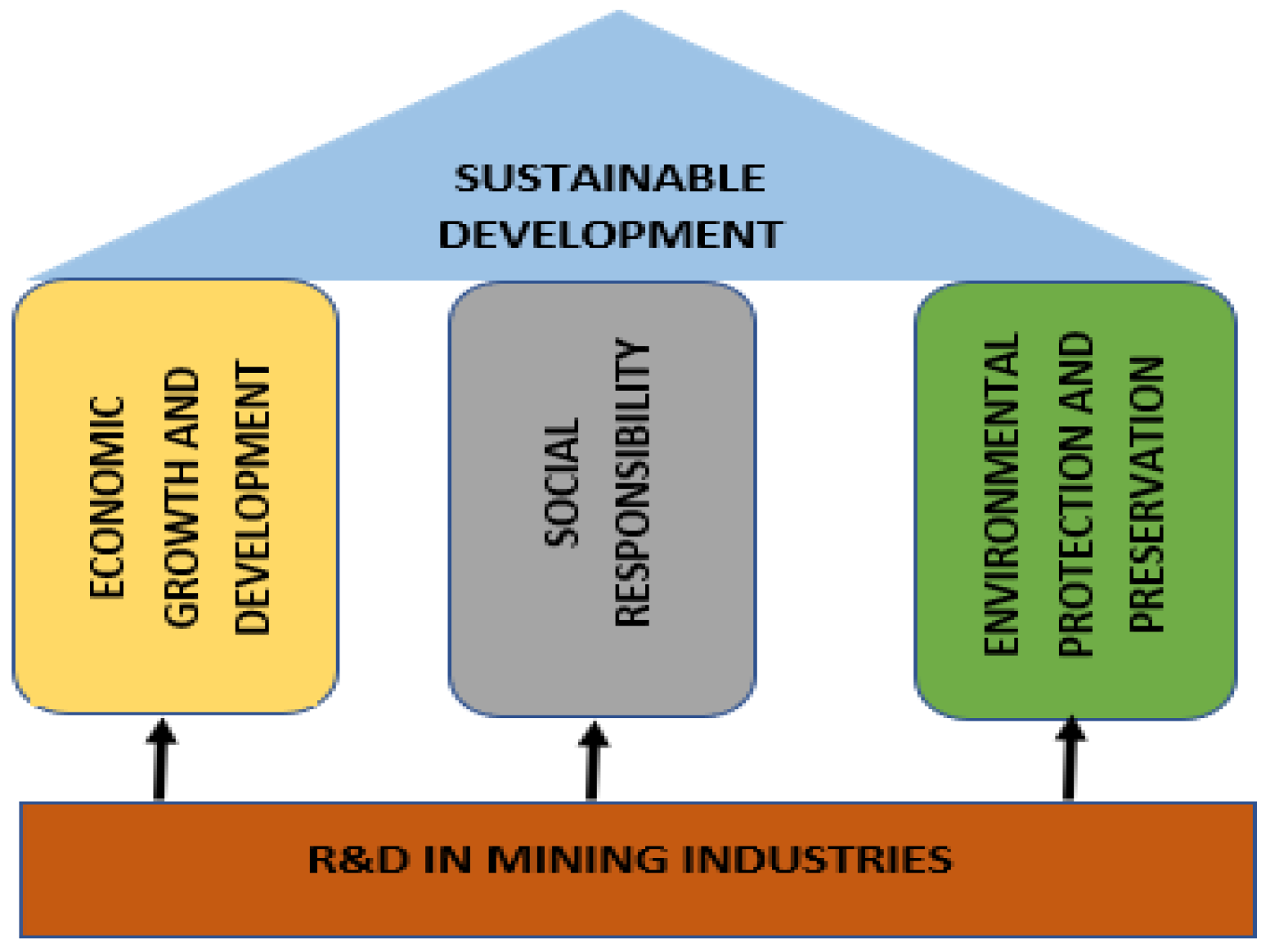
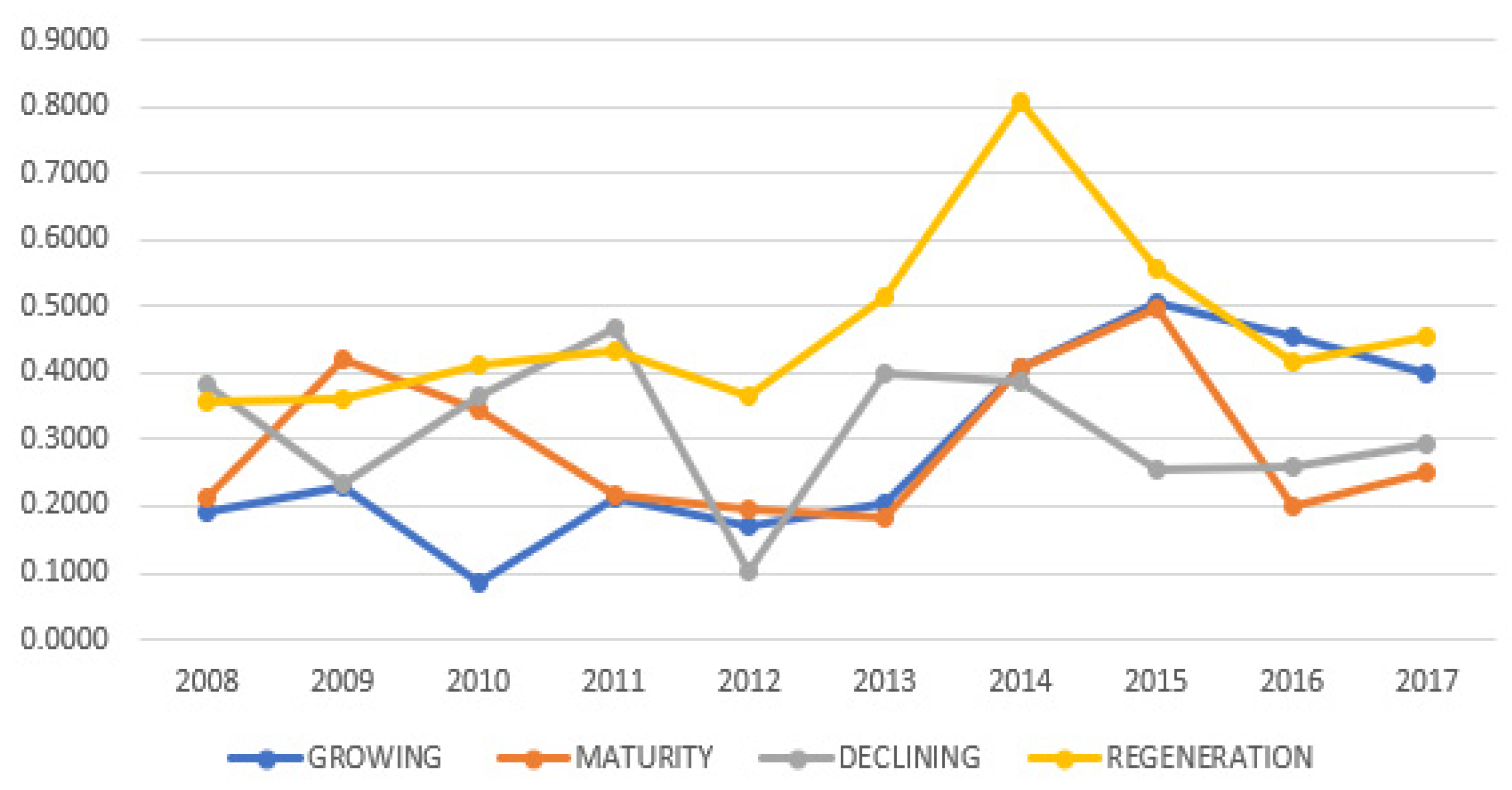

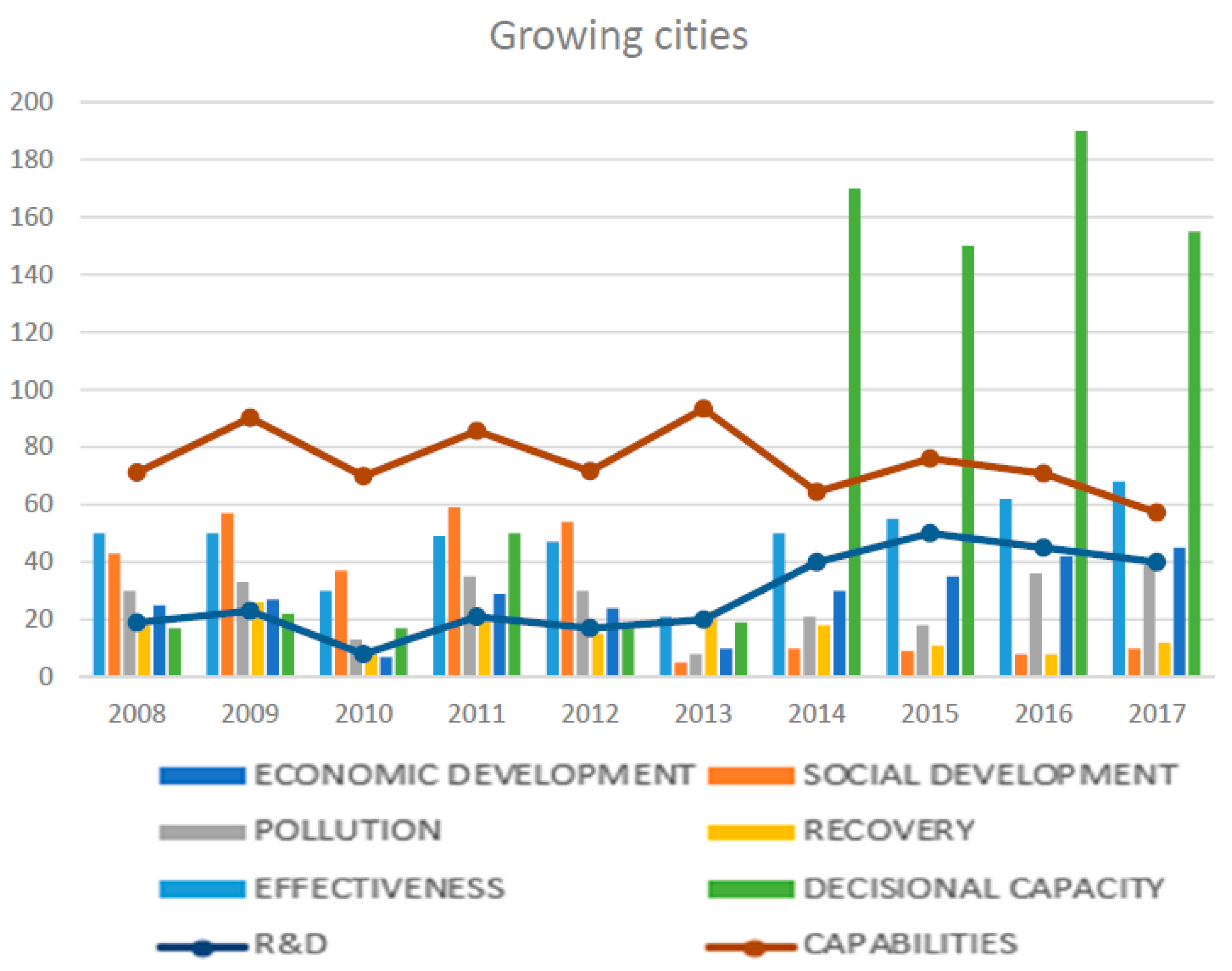
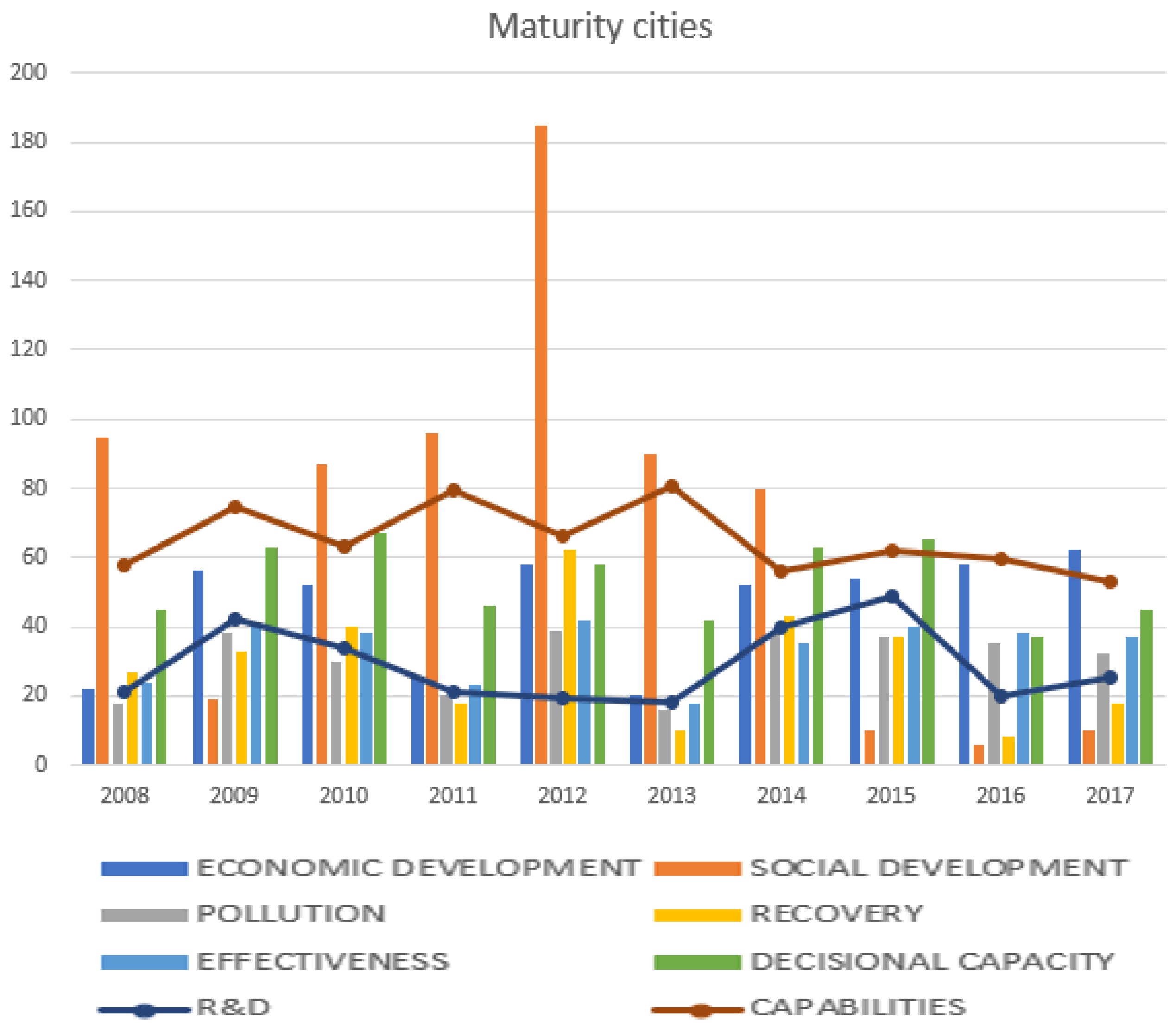

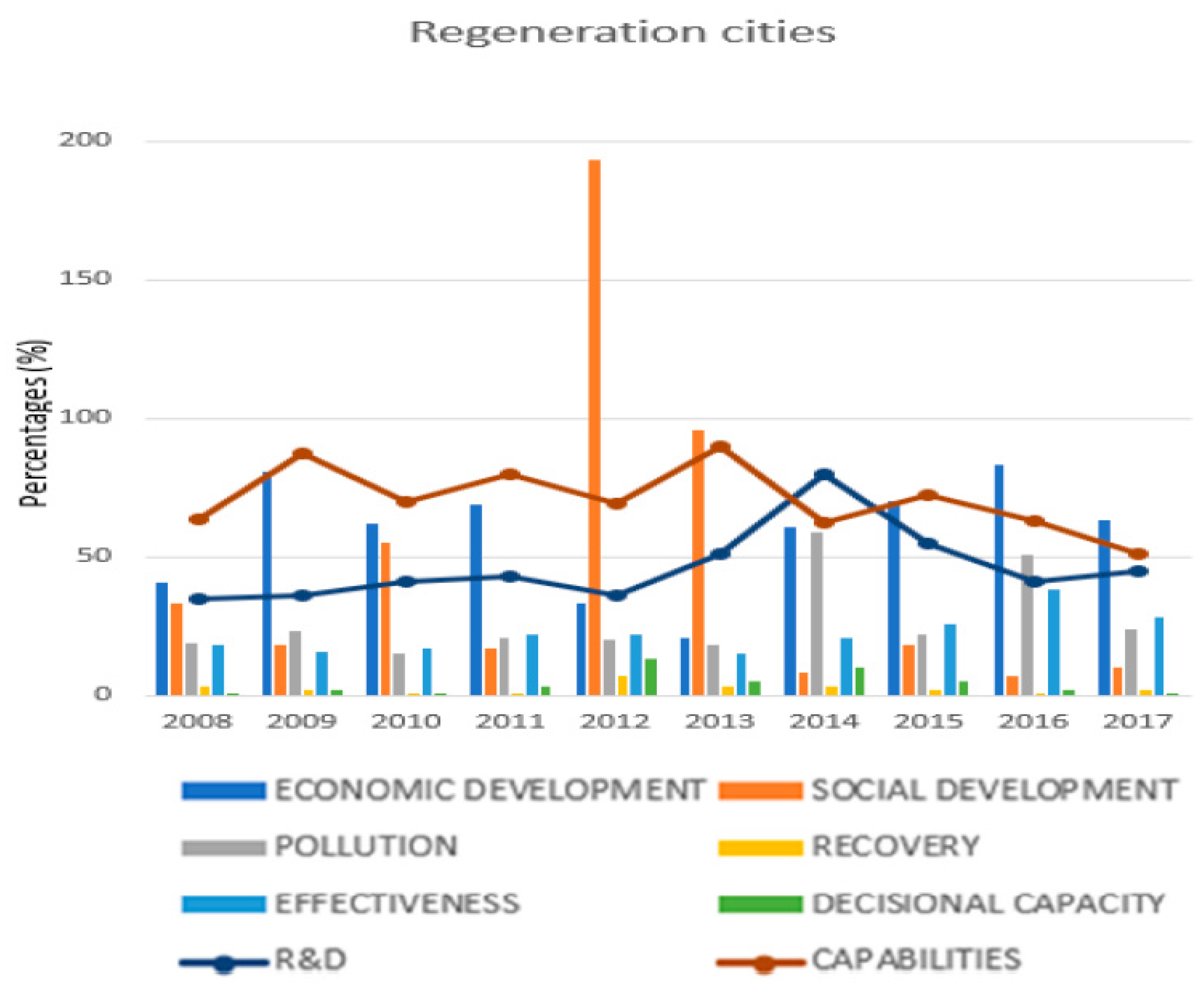
| Year | Total Production | As Percentage of Total Energy Production | |||
| Coal | Crude Oil | Natural Gas | Primary Electricity and Other Energy | ||
| 2008 | 277,419 | 76.8 | 9.8 | 3.9 | 9.5 |
| 2009 | 286,092 | 76.8 | 9.4 | 4.0 | 9.8 |
| 2010 | 312,125 | 76.2 | 9.3 | 4.1 | 10.4 |
| 2011 | 340,178 | 77.8 | 8.5 | 4.1 | 9.6 |
| 2012 | 351,041 | 76.2 | 8.5 | 4.1 | 11.2 |
| 2013 | 358,784 | 75.4 | 8.4 | 4.4 | 11.8 |
| 2014 | 361,866 | 73.6 | 8.4 | 4.7 | 13.3 |
| 2015 | 361,476 | 72.2 | 8.5 | 4.8 | 14.5 |
| 2016 | 346,037 | 69.8 | 8.2 | 5.2 | 16.8 |
| 2017 | 358,500 | 69.6 | 7.6 | 5.4 | 17.4 |
| Year | Consumption | As Percentage of Total Energy Consumption | |||
| Coal | Crude Oil | Natural Gas | Primary Electricity and Other Energy | ||
| 2008 | 320,611 | 71.5 | 16.7 | 3.4 | 8.4 |
| 2009 | 336,126 | 71.6 | 16.4 | 3.5 | 8.5 |
| 2010 | 360,648 | 69.2 | 17.4 | 4.0 | 9.4 |
| 2011 | 387,043 | 70.2 | 16.8 | 4.6 | 8.4 |
| 2012 | 402,138 | 68.5 | 17.0 | 4.8 | 9.7 |
| 2013 | 416,913 | 67.4 | 17.1 | 5.3 | 10.2 |
| 2014 | 425,806 | 65.6 | 17.4 | 5.7 | 11.3 |
| 2015 | 429,905 | 63.7 | 18.3 | 5.9 | 12.1 |
| 2016 | 435,819 | 62.0 | 18.5 | 6.2 | 13.3 |
| 2017 | 448,529 | 60.4 | 18.8 | 7.0 | 13.8 |
| Fundamental Layers | Resultant Indicators | Elementary Indicators |
|---|---|---|
| Required input: (m) | R&D: (ma) | Average spending rate on R&D: ma1 Average input of technological innovation: ma2 |
| Recovery: (mb) | Sewage treatment rate: mb1 Unharmful domestic waste treatment rate: mb2 Industrial solid waste treatment rate: mb3 | |
| Effectiveness: (mc) | Per capita potential value of main retained coal reserve: mc1 Per capita land area: mc2 Per capita energy consumption: mc3 Per capita used water resource: mc4 | |
| Decisional capacity: (md) | Level of decision-making capability: md1 Environmental sustainability consciousness: md2 Development and planning of coal rationality: md3 | |
| Required output: (s) | Economic impact: (sa) | Per capita gross domestic product: sa1 GDP growth rate: sa2 Profit and tax contributed from per hundred yuan of primary value of fixed asset in coal mining industries: sa3 Rate of employment: sa4 |
| Social impact: (sb) | Gross population growth rate: sb1 Fraction of non-mining population to total population: sb2 Per capita retail sales of consumer goods: sb3 Number of college graduates per 10,000: sb4 Per capita green space area: sb5 | |
| Unfavorable output: (q) | Industrial pollution: (q) | Per capita industrial waste water discharged: q1 Per capita SO2 emission: q2 Per capita CO2 emission: q3 |
| Number of Cities | List of Coal Mining Cities | Category |
|---|---|---|
| 7 | Ordos, Luipanshui, Shuozhou, HulumBuir, Xianyang, Yanan, and Yulin | Growing |
| 21 | Luliang, Zhangjiakou, Xinzhou, Datong, Luliang, Yangquan, Changzhi, Xingtai, Jincheng, Linfen, Chifeng, Jixi, Pingdingshan, Hebi, Huainan, Handan, Jinzhong, Jining, Guangyuan, Dazhou, Anshun, and Qujing | Maturity |
| 13 | Wuhai, Hegang, Shuangyashan, Jiaozuo, Huaibei, Fushun, Fuxin, Shizuishan, Liaoyuan, Qitaihe, Pingxiang, and Zaozhuang | Declining |
| 4 | Tongchuan, Tangshan, Xuzhou, Linyi, and Taiyuan | Regeneration |
| Year | Growing | Maturity | Declining | Regeneration | Mean |
|---|---|---|---|---|---|
| 2008 | 0.1933 | 0.2112 | 0.3811 | 0.3568 | 0.2856 |
| 2009 | 0.2314 | 0.4211 | 0.2345 | 0.3611 | 0.3120 |
| 2010 | 0.0872 | 0.3444 | 0.3661 | 0.4109 | 0.3022 |
| 2011 | 0.2140 | 0.2190 | 0.4672 | 0.4322 | 0.3331 |
| 2012 | 0.1705 | 0.1936 | 0.1008 | 0.3661 | 0.2078 |
| 2013 | 0.2045 | 0.1818 | 0.4010 | 0.5135 | 0.3252 |
| 2014 | 0.4090 | 0.4061 | 0.3880 | 0.8088 | 0.5030 |
| 2015 | 0.5077 | 0.4980 | 0.2551 | 0.5554 | 0.4541 |
| 2016 | 0.4562 | 0.2008 | 0.2612 | 0.4166 | 0.3337 |
| 2017 | 0.4001 | 0.2511 | 0.2921 | 0.4533 | 0.3492 |
| Mean | 0.2874 | 0.2927 | 0.3147 | 0.4675 | 0.3406 |
| Year | Growing | Maturity | Declining | Regeneration | Mean |
|---|---|---|---|---|---|
| 2008 | 0.7114 | 0.5799 | 0.6232 | 0.6351 | 0.6374 |
| 2009 | 0.9021 | 0.7444 | 0.7120 | 0.8708 | 0.8073 |
| 2010 | 0.6986 | 0.6322 | 0.6241 | 0.6986 | 0.6634 |
| 2011 | 0.8566 | 0.7965 | 0.7211 | 0.7991 | 0.7933 |
| 2012 | 0.7164 | 0.6612 | 0.6119 | 0.6941 | 0.6709 |
| 2013 | 0.9338 | 0.8090 | 0.9172 | 0.8991 | 0.8898 |
| 2014 | 0.6444 | 0.5611 | 0.6006 | 0.6211 | 0.6068 |
| 2015 | 0.7600 | 0.6194 | 0.6297 | 0.7213 | 0.6826 |
| 2016 | 0.7079 | 0.5959 | 0.6093 | 0.6314 | 0.6361 |
| 2017 | 0.5721 | 0.5321 | 0.5081 | 0.5081 | 0.5301 |
| Mean | 0.7503 | 0.6532 | 0.6557 | 0.7079 | 0.6918 |
| Year | Effch | Techch | Pech | Sech | Tfpch |
|---|---|---|---|---|---|
| 2008–2009 | 0.991 | 1.033 | 0.999 | 0.989 | 1.021 |
| 2009–2010 | 0.708 | 0.954 | 0.894 | 0.866 | 0.775 |
| 2010–2011 | 0.839 | 1.118 | 1.101 | 0.707 | 0.791 |
| 2011–2012 | 0.750 | 1.145 | 0.806 | 0.930 | 0.866 |
| 2012–2013 | 1.401 | 1.111 | 1.212 | 0.943 | 1.414 |
| 2013–2014 | 1.061 | 1.155 | 1.106 | 1.414 | 1.265 |
| 2014–2015 | 1.051 | 1.437 | 1.125 | 0.861 | 1.054 |
| 2015–2016 | 0.949 | 1.048 | 1.201 | 0.949 | 1.095 |
| 2016–2017 | 0.978 | 1.097 | 1.012 | 1.061 | 1.118 |
| Mean | 0.970 | 1.122 | 1.051 | 0.969 | 1.044 |
Publisher’s Note: MDPI stays neutral with regard to jurisdictional claims in published maps and institutional affiliations. |
© 2021 by the authors. Licensee MDPI, Basel, Switzerland. This article is an open access article distributed under the terms and conditions of the Creative Commons Attribution (CC BY) license (https://creativecommons.org/licenses/by/4.0/).
Share and Cite
Du, J.; Dabuo, F.T.; Madzikanda, B.; Boamah, K.B. The Influence of R&D in Mining on Sustainable Development in China. Sustainability 2021, 13, 5289. https://doi.org/10.3390/su13095289
Du J, Dabuo FT, Madzikanda B, Boamah KB. The Influence of R&D in Mining on Sustainable Development in China. Sustainability. 2021; 13(9):5289. https://doi.org/10.3390/su13095289
Chicago/Turabian StyleDu, Jianguo, Francis Tang Dabuo, Beverlley Madzikanda, and Kofi Baah Boamah. 2021. "The Influence of R&D in Mining on Sustainable Development in China" Sustainability 13, no. 9: 5289. https://doi.org/10.3390/su13095289
APA StyleDu, J., Dabuo, F. T., Madzikanda, B., & Boamah, K. B. (2021). The Influence of R&D in Mining on Sustainable Development in China. Sustainability, 13(9), 5289. https://doi.org/10.3390/su13095289





